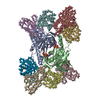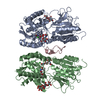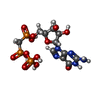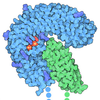+ Open data
Open data
- Basic information
Basic information
| Entry |  | |||||||||
|---|---|---|---|---|---|---|---|---|---|---|
| Title | Cyclase domain of GC-A bound to ANP | |||||||||
 Map data Map data | ||||||||||
 Sample Sample |
| |||||||||
 Keywords Keywords | Single pass transmembrane protein / guanylyl cyclase / atrial natriuretic peptide receptor / hypertension / membrane protein / LYASE | |||||||||
| Function / homology |  Function and homology information Function and homology informationANPR-A receptor complex / natriuretic peptide receptor activity / : / receptor guanylyl cyclase signaling pathway / body fluid secretion / peptide receptor activity / positive regulation of renal sodium excretion / guanylate cyclase / cGMP biosynthetic process / guanylate cyclase activity ...ANPR-A receptor complex / natriuretic peptide receptor activity / : / receptor guanylyl cyclase signaling pathway / body fluid secretion / peptide receptor activity / positive regulation of renal sodium excretion / guanylate cyclase / cGMP biosynthetic process / guanylate cyclase activity / Physiological factors / regulation of vascular permeability / positive regulation of urine volume / G protein-coupled peptide receptor activity / : / dopamine metabolic process / hormone binding / peptide hormone binding / negative regulation of angiogenesis / blood vessel diameter maintenance / negative regulation of smooth muscle cell proliferation / negative regulation of cell growth / regulation of blood pressure / cell surface receptor signaling pathway / protein kinase activity / receptor complex / GTP binding / ATP binding / plasma membrane Similarity search - Function | |||||||||
| Biological species |  Homo sapiens (human) / Homo sapiens (human) /  | |||||||||
| Method | single particle reconstruction / cryo EM / Resolution: 3.2 Å | |||||||||
 Authors Authors | Liu S / Huang X | |||||||||
| Funding support |  United States, 1 items United States, 1 items
| |||||||||
 Citation Citation |  Journal: Nat Struct Mol Biol / Year: 2025 Journal: Nat Struct Mol Biol / Year: 2025Title: Architecture and activation of single-pass transmembrane receptor guanylyl cyclase. Authors: Shian Liu / Alexander M Payne / Jinan Wang / Lan Zhu / Navid Paknejad / Edward T Eng / Wei Liu / Yinglong Miao / Richard K Hite / Xin-Yun Huang /  Abstract: The heart, in addition to its primary role in blood circulation, functions as an endocrine organ by producing cardiac hormone natriuretic peptides. These hormones regulate blood pressure through the ...The heart, in addition to its primary role in blood circulation, functions as an endocrine organ by producing cardiac hormone natriuretic peptides. These hormones regulate blood pressure through the single-pass transmembrane receptor guanylyl cyclase A (GC-A), also known as natriuretic peptide receptor 1. The binding of the peptide hormones to the extracellular domain of the receptor activates the intracellular guanylyl cyclase domain of the receptor to produce the second messenger cyclic guanosine monophosphate. Despite their importance, the detailed architecture and domain interactions within full-length GC-A remain elusive. Here we present cryo-electron microscopy structures, functional analyses and molecular dynamics simulations of full-length human GC-A, in both the absence and the presence of atrial natriuretic peptide. The data reveal the architecture of full-length GC-A, highlighting the spatial arrangement of its various functional domains. This insight is crucial for understanding how different parts of the receptor interact and coordinate during activation. The study elucidates the molecular basis of how extracellular signals are transduced across the membrane to activate the intracellular guanylyl cyclase domain. | |||||||||
| History |
|
- Structure visualization
Structure visualization
| Supplemental images |
|---|
- Downloads & links
Downloads & links
-EMDB archive
| Map data |  emd_44440.map.gz emd_44440.map.gz | 33.2 MB |  EMDB map data format EMDB map data format | |
|---|---|---|---|---|
| Header (meta data) |  emd-44440-v30.xml emd-44440-v30.xml emd-44440.xml emd-44440.xml | 17.7 KB 17.7 KB | Display Display |  EMDB header EMDB header |
| Images |  emd_44440.png emd_44440.png | 44.8 KB | ||
| Filedesc metadata |  emd-44440.cif.gz emd-44440.cif.gz | 6.5 KB | ||
| Others |  emd_44440_half_map_1.map.gz emd_44440_half_map_1.map.gz emd_44440_half_map_2.map.gz emd_44440_half_map_2.map.gz | 59.4 MB 59.4 MB | ||
| Archive directory |  http://ftp.pdbj.org/pub/emdb/structures/EMD-44440 http://ftp.pdbj.org/pub/emdb/structures/EMD-44440 ftp://ftp.pdbj.org/pub/emdb/structures/EMD-44440 ftp://ftp.pdbj.org/pub/emdb/structures/EMD-44440 | HTTPS FTP |
-Validation report
| Summary document |  emd_44440_validation.pdf.gz emd_44440_validation.pdf.gz | 1 MB | Display |  EMDB validaton report EMDB validaton report |
|---|---|---|---|---|
| Full document |  emd_44440_full_validation.pdf.gz emd_44440_full_validation.pdf.gz | 1 MB | Display | |
| Data in XML |  emd_44440_validation.xml.gz emd_44440_validation.xml.gz | 12.4 KB | Display | |
| Data in CIF |  emd_44440_validation.cif.gz emd_44440_validation.cif.gz | 14.7 KB | Display | |
| Arichive directory |  https://ftp.pdbj.org/pub/emdb/validation_reports/EMD-44440 https://ftp.pdbj.org/pub/emdb/validation_reports/EMD-44440 ftp://ftp.pdbj.org/pub/emdb/validation_reports/EMD-44440 ftp://ftp.pdbj.org/pub/emdb/validation_reports/EMD-44440 | HTTPS FTP |
-Related structure data
| Related structure data |  9bcvMC  9bclC  9bcnC  9bcoC  9bcpC  9bcqC  9bcsC M: atomic model generated by this map C: citing same article ( |
|---|---|
| Similar structure data | Similarity search - Function & homology  F&H Search F&H Search |
- Links
Links
| EMDB pages |  EMDB (EBI/PDBe) / EMDB (EBI/PDBe) /  EMDataResource EMDataResource |
|---|---|
| Related items in Molecule of the Month |
- Map
Map
| File |  Download / File: emd_44440.map.gz / Format: CCP4 / Size: 64 MB / Type: IMAGE STORED AS FLOATING POINT NUMBER (4 BYTES) Download / File: emd_44440.map.gz / Format: CCP4 / Size: 64 MB / Type: IMAGE STORED AS FLOATING POINT NUMBER (4 BYTES) | ||||||||||||||||||||||||||||||||||||
|---|---|---|---|---|---|---|---|---|---|---|---|---|---|---|---|---|---|---|---|---|---|---|---|---|---|---|---|---|---|---|---|---|---|---|---|---|---|
| Projections & slices | Image control
Images are generated by Spider. | ||||||||||||||||||||||||||||||||||||
| Voxel size | X=Y=Z: 1.19 Å | ||||||||||||||||||||||||||||||||||||
| Density |
| ||||||||||||||||||||||||||||||||||||
| Symmetry | Space group: 1 | ||||||||||||||||||||||||||||||||||||
| Details | EMDB XML:
|
-Supplemental data
-Half map: #2
| File | emd_44440_half_map_1.map | ||||||||||||
|---|---|---|---|---|---|---|---|---|---|---|---|---|---|
| Projections & Slices |
| ||||||||||||
| Density Histograms |
-Half map: #1
| File | emd_44440_half_map_2.map | ||||||||||||
|---|---|---|---|---|---|---|---|---|---|---|---|---|---|
| Projections & Slices |
| ||||||||||||
| Density Histograms |
- Sample components
Sample components
-Entire : Atrial natriuretic peptide receptor 1 dimer
| Entire | Name: Atrial natriuretic peptide receptor 1 dimer |
|---|---|
| Components |
|
-Supramolecule #1: Atrial natriuretic peptide receptor 1 dimer
| Supramolecule | Name: Atrial natriuretic peptide receptor 1 dimer / type: complex / ID: 1 / Parent: 0 / Macromolecule list: #1-#2 |
|---|---|
| Source (natural) | Organism:  Homo sapiens (human) Homo sapiens (human) |
-Macromolecule #1: Atrial natriuretic peptide receptor 1
| Macromolecule | Name: Atrial natriuretic peptide receptor 1 / type: protein_or_peptide / ID: 1 / Number of copies: 2 / Enantiomer: LEVO / EC number: guanylate cyclase |
|---|---|
| Source (natural) | Organism:  Homo sapiens (human) Homo sapiens (human) |
| Molecular weight | Theoretical: 115.560688 KDa |
| Recombinant expression | Organism:  |
| Sequence | String: GNLTVAVVLP LANTSYPWSW ARVGPAVELA LAQVKARPDL LPGWTVRTVL GSSENALGVC SDTAAPLAAV DLKWEHNPAV FLGPGCVYA AAPVGRFTAH WRVPLLTAGA PALGFGVKDE YALTTRAGPS YAKLGDFVAA LHRRLGWERQ ALMLYAYRPG D EEHCFFLV ...String: GNLTVAVVLP LANTSYPWSW ARVGPAVELA LAQVKARPDL LPGWTVRTVL GSSENALGVC SDTAAPLAAV DLKWEHNPAV FLGPGCVYA AAPVGRFTAH WRVPLLTAGA PALGFGVKDE YALTTRAGPS YAKLGDFVAA LHRRLGWERQ ALMLYAYRPG D EEHCFFLV EGLFMRVRDR LNITVDHLEF AEDDLSHYTR LLRTMPRKGR VIYICSSPDA FRTLMLLALE AGLCGEDYVF FH LDIFGQS LQGGQGPAPR RPWERGDGQD VSARQAFQAA KIITYKDPDN PEYLEFLKQL KHLAYEQFNF TMEDGLVNTI PAS FHDGLL LYIQAVTETL AHGGTVTDGE NITQRMWNRS FQGVTGYLKI DSSGDRETDF SLWDMDPENG AFRVVLNYNG TSQE LVAVS GRKLNWPLGY PPPDIPKCGF DNEDPACNQD HLSTLEVLAL VGSLSLLGIL IVSFFIYRKM QLEKELASEL WRVRW EDVE PSSLERHLRS AGSRLTLSGR GSNYGSLLTT EGQFQVFAKT AYYKGNLVAV KRVNRKRIEL TRKVLFELKH MRDVQN EHL TRFVGACTDP PNICILTEYC PRGSLQDILE NESITLDWMF RYSLTNDIVK GMLFLHNGAI CSHGNLKSSN CVVDGRF VL KITDYGLESF RDLDPEQGHT VYAKKLWTAP ELLRMASPPV RGSQAGDVYS FGIILQEIAL RSGVFHVEGL DLSPKEII E RVTRGEQPPF RPSLALQSHL EELGLLMQRC WAEDPQERPP FQQIRLTLRK FNRENSSNIL DNLLSRMEQY ANNLEELVE ERTQAYLEEK RKAEALLYQI LPHSVAEQLK RGETVQAEAF DSVTIYFSDI VGFTALSAES TPMQVVTLLN DLYTCFDAVI DNFDVYKVE TIGDAYMVVS GLPVRNGRLH ACEVARMALA LLDAVRSFRI RHRPQEQLRL RIGIHTGPVC AGVVGLKMPR Y CLFGDTVN TASRMESNGE ALKIHLSSET KAVLEEFGGF ELELRGDVEM KGKGKVRTYW LLGERGSSTR G UniProtKB: Atrial natriuretic peptide receptor 1 |
-Macromolecule #2: Fab fragment
| Macromolecule | Name: Fab fragment / type: protein_or_peptide / ID: 2 / Number of copies: 8 / Enantiomer: LEVO |
|---|---|
| Source (natural) | Organism:  |
| Molecular weight | Theoretical: 10.230603 KDa |
| Recombinant expression | Organism:  Homo sapiens (human) Homo sapiens (human) |
| Sequence | String: (UNK)(UNK)(UNK)(UNK)(UNK)(UNK)(UNK)(UNK)(UNK)(UNK) (UNK)(UNK)(UNK)(UNK)(UNK)(UNK) (UNK)(UNK)(UNK) (UNK)(UNK)(UNK)(UNK)(UNK)(UNK)(UNK)(UNK)(UNK)(UNK) (UNK)(UNK)(UNK) (UNK)(UNK)(UNK)(UNK)(UNK) ...String: (UNK)(UNK)(UNK)(UNK)(UNK)(UNK)(UNK)(UNK)(UNK)(UNK) (UNK)(UNK)(UNK)(UNK)(UNK)(UNK) (UNK)(UNK)(UNK) (UNK)(UNK)(UNK)(UNK)(UNK)(UNK)(UNK)(UNK)(UNK)(UNK) (UNK)(UNK)(UNK) (UNK)(UNK)(UNK)(UNK)(UNK)(UNK) (UNK)(UNK)(UNK)(UNK)(UNK)(UNK)(UNK)(UNK)(UNK)(UNK) (UNK)(UNK)(UNK)(UNK)(UNK)(UNK)(UNK)(UNK)(UNK) (UNK)(UNK)(UNK)(UNK)(UNK)(UNK)(UNK) (UNK)(UNK) (UNK)(UNK)(UNK)(UNK)(UNK)(UNK)(UNK)(UNK)(UNK)(UNK) (UNK)(UNK)(UNK)(UNK) (UNK)(UNK)(UNK)(UNK)(UNK) (UNK)(UNK)(UNK)(UNK)(UNK)(UNK)(UNK)(UNK)(UNK)(UNK) (UNK) (UNK)(UNK)(UNK)(UNK)(UNK)(UNK)(UNK)(UNK) (UNK)(UNK)(UNK)(UNK)(UNK)(UNK)(UNK)(UNK) (UNK) (UNK)(UNK)(UNK)(UNK)(UNK)(UNK)(UNK) |
-Macromolecule #3: PHOSPHOMETHYLPHOSPHONIC ACID GUANYLATE ESTER
| Macromolecule | Name: PHOSPHOMETHYLPHOSPHONIC ACID GUANYLATE ESTER / type: ligand / ID: 3 / Number of copies: 2 / Formula: G2P |
|---|---|
| Molecular weight | Theoretical: 521.208 Da |
| Chemical component information |  ChemComp-G2P: |
-Macromolecule #4: MAGNESIUM ION
| Macromolecule | Name: MAGNESIUM ION / type: ligand / ID: 4 / Number of copies: 2 / Formula: MG |
|---|---|
| Molecular weight | Theoretical: 24.305 Da |
-Experimental details
-Structure determination
| Method | cryo EM |
|---|---|
 Processing Processing | single particle reconstruction |
| Aggregation state | particle |
- Sample preparation
Sample preparation
| Concentration | 1 mg/mL |
|---|---|
| Buffer | pH: 8 |
| Vitrification | Cryogen name: ETHANE |
- Electron microscopy
Electron microscopy
| Microscope | TFS GLACIOS |
|---|---|
| Image recording | Film or detector model: FEI FALCON IV (4k x 4k) / Average electron dose: 40.0 e/Å2 |
| Electron beam | Acceleration voltage: 200 kV / Electron source:  FIELD EMISSION GUN FIELD EMISSION GUN |
| Electron optics | Illumination mode: FLOOD BEAM / Imaging mode: BRIGHT FIELD / Nominal defocus max: 1.5 µm / Nominal defocus min: 0.8 µm |
- Image processing
Image processing
| Startup model | Type of model: NONE |
|---|---|
| Final reconstruction | Resolution.type: BY AUTHOR / Resolution: 3.2 Å / Resolution method: FSC 0.143 CUT-OFF / Number images used: 112661 |
| Initial angle assignment | Type: MAXIMUM LIKELIHOOD |
| Final angle assignment | Type: MAXIMUM LIKELIHOOD |
 Movie
Movie Controller
Controller


















 Z (Sec.)
Z (Sec.) Y (Row.)
Y (Row.) X (Col.)
X (Col.)




































